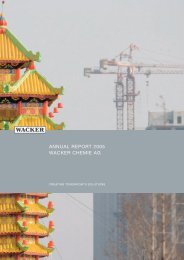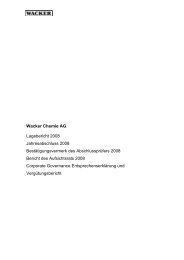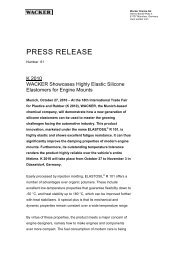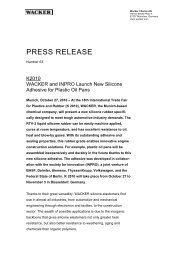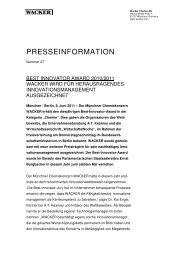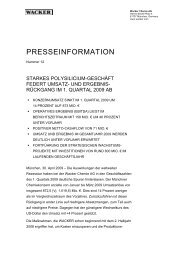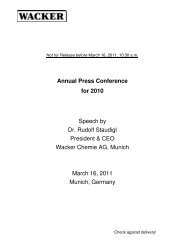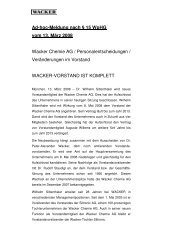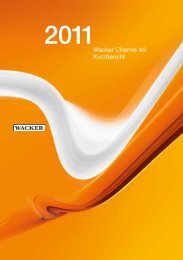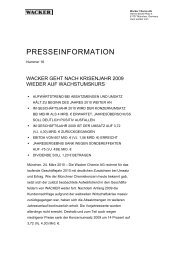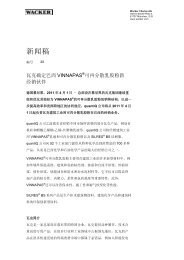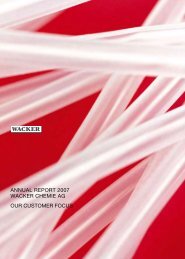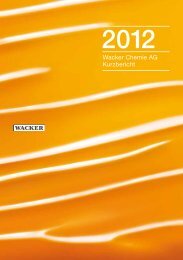Silicones for Prosthetics (PDF | 856 KB) - Wacker Chemie
Silicones for Prosthetics (PDF | 856 KB) - Wacker Chemie
Silicones for Prosthetics (PDF | 856 KB) - Wacker Chemie
Create successful ePaper yourself
Turn your PDF publications into a flip-book with our unique Google optimized e-Paper software.
hEALThcArE I PrOSThETIcS<br />
SILIcOnES fOr<br />
PrOSThETIcS<br />
crEATIng TOMOrrOW‘S SOLuTIOnS
AS fAScInATIngLy vErSATILE<br />
AS ThE huMAn bOdy<br />
Silicone Elastomers from<br />
WAckEr – Per<strong>for</strong>mance<br />
next to the Skin<br />
The human body is a wonderful work<br />
of art and highly complex piece of<br />
engineering. When it is necessary to<br />
provide support or artificial replacements<br />
<strong>for</strong> particular physical functions<br />
in the human body, or to promote<br />
healing, WACKER silicones convince<br />
with a customized range of products<br />
and services.<br />
2<br />
All products in the medical silicone sector<br />
have one thing in common – they come<br />
into intimate contact with the human<br />
body, where they enhance quality of life<br />
by providing support in terms of functionality<br />
and aesthetics. That is why the<br />
materials must satisfy such rigorous demands.<br />
WACKER silicone rubbers meet<br />
this challenge with high compatibility and<br />
excellent reliability.<br />
Our product program is impressive due<br />
to its remarkable scope of applications.<br />
Individual service and personalized<br />
consultancy also play an important role<br />
at WACKER.
ELASTOSIL ® –<br />
<strong>for</strong> Manufacturing<br />
Mammary Prostheses<br />
Step 1<br />
• The mammary prosthesis consists of a<br />
thin shell (e.g. PUR) filled with silicone gel<br />
Step 4<br />
• The shape of the prosthesis is set using a<br />
negative mold<br />
3<br />
Step 2<br />
• The use of thermoplastic shell material<br />
makes it possible to shape prostheses<br />
individually<br />
• The shell is comparable to a bag with<br />
a feeding channel<br />
Step 5<br />
• ELASTOSIL ® gel begins curing at room<br />
temperature<br />
• The process can be accelerated by heat<br />
input (approx. 70° C - 130° C)<br />
Step 3<br />
• The shell is filled with ELASTOSIL ® gel<br />
Step 6<br />
• The prosthesis is then demolded and<br />
packed
Silicone rubbers,<br />
customized <strong>for</strong><br />
Prosthetic Applications<br />
Reliable Per<strong>for</strong>mance in the<br />
Prosthetic Industry<br />
Our silicones are used in many prosthetic<br />
applications, ranging from the manufacture<br />
of functional prostheses <strong>for</strong> fingers, hands<br />
and partial-foot prostheses to the production<br />
of orthoses, epitheses and external<br />
breast prostheses, to liners and face<br />
masks, tailored to fit the wearer perfectly.<br />
WACKER offers tailored solutions <strong>for</strong> the<br />
medical industry’s special requirements.<br />
Our product ranges comprise ready-touse<br />
grades. Not only can their hardness<br />
be varied, but their consistency adjusted<br />
from spreadable to fluid. We have also developed<br />
customized solutions <strong>for</strong> special<br />
applications.<br />
ELASTOSIL ® RTV-2 Silicone Rubber Grades <strong>for</strong> <strong>Prosthetics</strong><br />
RTV-2 Systems Make<br />
the Difference<br />
Various silicone-rubber systems are used,<br />
depending on the specific prosthetic application.<br />
The addition-curing grades are<br />
<strong>for</strong>mulated as two-component systems:<br />
A and B. The platinum catalyst is separated<br />
from the crosslinker. After components<br />
A and B have been mixed, the mixture<br />
cures to an elastomer.<br />
The main difference between RTV-2 silicones<br />
and other standard silicone types<br />
(such as LSR or HTV) is a lower processing<br />
viscosity, which results in very good<br />
pourability. The vulcanizate hardnesses<br />
range from very soft (Shore 00) to hard<br />
(Shore A), and can be widely varied.<br />
The pot lives and curing times of our<br />
ELASTOSIL ® grades can be adapted,<br />
making these grades suitable <strong>for</strong> standard<br />
manufacturing processes. They can<br />
be applied in a number of ways such as<br />
molding, brushing or dipping. After mixing,<br />
RTV-2 silicone rubbers start curing at<br />
room temperature; this process can be<br />
accelerated by increasing the temperature<br />
(e.g. 70° C - 130° C).<br />
Blending Viscosity Viscosity Final Final Tensile Elongation Tear resistance<br />
ratio Component A Component B hardness hardness strength at break ASTM D 624 B<br />
Shore A Shore 00 ISO 37 ISO 37<br />
ISO 868 ASTM 2240<br />
Designation A : B [mPa·s] [mPa·s] [N / mm²] [%] [N / mm]<br />
ELASTOSIL ® P 7600 1:1 4,000 2,000 < 0 26 1.0 600 1.5<br />
ELASTOSIL ® P 7613 1:1 12,000 12,000 15 - 2.1 400 3.2<br />
ELASTOSIL ® P 7670 1:1 1,800 1,800 7 55 1.8 600 2.1<br />
ELASTOSIL ® P 7671 1:1 1,800 1,800 < 0 18 0.5 400 1.5<br />
ELASTOSIL ® P 7676 1:1 1,500 1,500 < 0 15 0.6 500 1.0<br />
ELASTOSIL ® P 7684 / 40 1:1 2,000 3,000 < 0 40 2.0 600 6.0<br />
ELASTOSIL ® P 7684 / 60 1:1 2,000 3,000 12 60 3.0 600 13.0<br />
ELASTOSIL ® P 7683 / 25 1:1 1,400 4,000 < 0 25 1.0 500 2.0<br />
ELASTOSIL ® P 7683 / 47 1:1 1,600 1,600 7 47 2.4 470 7.0<br />
ELASTOSIL ® P 7915 1:1 kneadable kneadable 17 70 1.2 550 5.0<br />
ELASTOSIL ® P 7950 1:1 kneadable kneadable 50 - 2.4 250 7.0<br />
ELASTOSIL ® PK 16 1:1 3,500 4,000 < 0 18 1.0 850 3.0<br />
These figures are intended as a guide and should not be used in preparing specifications.<br />
ELASTOSIL ® is a registered trademark of WAckEr chemie Ag<br />
hand prosthesis<br />
Liner <strong>for</strong> leg prosthesis<br />
Mixing the components<br />
4
Silicone gels <strong>for</strong><br />
External Mammary<br />
<strong>Prosthetics</strong><br />
External Mammary Prostheses Made<br />
of Soft Silicone Gels<br />
The products used in external mammary<br />
prosthetics must meet very specialized<br />
demands. We have there<strong>for</strong>e developed<br />
our RTV-2 silicone gels in close cooperation<br />
with manufacturers.<br />
The results are impressive: ELASTOSIL ®<br />
silicone gels can be adjusted to any desired<br />
softness, color and resilience. They<br />
offer all advantages of RTV-2 silicone<br />
grades. Silicone gels are superior to other<br />
materials because they provide a natural<br />
feel and look. We also offer silicone gels<br />
<strong>for</strong> “lightweight” prostheses to reduce<br />
the weight of the silicone <strong>for</strong> the wearer.<br />
These gels are less dense and there<strong>for</strong>e<br />
their inherent weight is reduced.<br />
The Advantages of ELASTOSIL ® P<br />
• Low viscosity<br />
• Easy to meter, thanks to its non-critical<br />
mixing behavior<br />
• Homogenization quality during mixing can<br />
be easily monitored because the components<br />
are differently colored<br />
• Adheres perfectly to polyurethane film<br />
• Provides a natural look and feel<br />
ELASTOSIL ® RTV-2 Silicone Gels <strong>for</strong> External Mammary Prostheses<br />
Blending Viscosity Viscosity Pot life<br />
Gel time Penetration, hollow cone<br />
ratio Component A Component B at 23° C at 70° C 62.5 g <strong>for</strong> 5 sec.<br />
Designation A : B [mPa·s] [mPa·s] [h] [min] [1 / 10 mm]<br />
ELASTOSIL ® P 7616-160 1:1 350 1,400 > 6 22 160*<br />
ELASTOSIL ® P 7616-195 1:1 350 1,200 > 4 12 195*<br />
ELASTOSIL ® P 7618 1:1 50 300 > 6 15 220<br />
ELASTOSIL ® P 7619 2:1 100 1,250 > 6 22 200<br />
ELASTOSIL ® P 7628 1:1 8,000 8,000 0,5 3 192; density (0.62 g / cm³)<br />
ELASTOSIL ® P 7630 1:1 8,000 8,000 0,5 3 220; density (0.62 g / cm³)<br />
ELASTOSIL ® P 7633 1:1 6,500 6,500 > 2 > 60 240; density (0.67 g / cm³)<br />
ELASTOSIL ® P 7636 1:1 8,000 8,000 4 10 258; density (0.76 g / cm³)<br />
* hollow cone of 25 g, 5 sec.<br />
These figures are intended as a guide and should not be used in preparing specifications.<br />
5
<strong>Wacker</strong> <strong>Chemie</strong> AG<br />
Hanns-Seidel-Platz 4<br />
81737 Munich, Germany<br />
Tel. + 49 89 6279-0<br />
info@wacker.com<br />
www.wacker.com/silpuran<br />
The data presented in this brochure are in accordance with the present state of our knowledge but do not absolve the user from carefully checking all supplies immediately on receipt.<br />
We reserve the right to alter product constants within the scope of technical progress or new developments. The recommendations made in this brochure should be checked by preliminary<br />
trials because of conditions during processing over which we have no control, especially where other companies’ raw materials are also being used. The in<strong>for</strong>mation provided by us<br />
does not absolve the user from the obligation of investigating the possibility of infringement of third parties’ rights and, if necessary, clarifying the position. recommendations <strong>for</strong> use do<br />
not constitute a warranty, either express or implied, of the fi tness or suitability of the product <strong>for</strong> a particular purpose.<br />
6365f e /10.12 supersedes 6365f e /11.11


